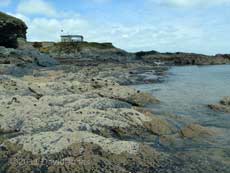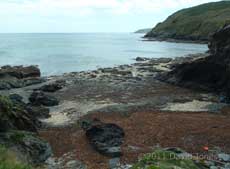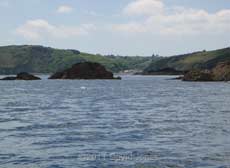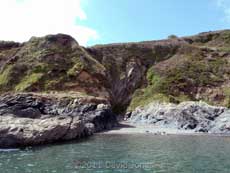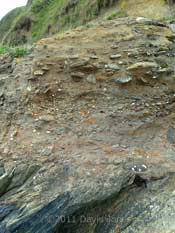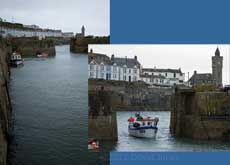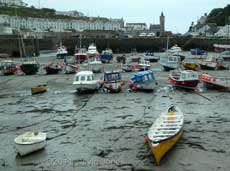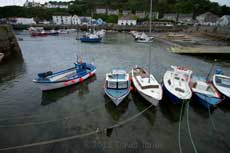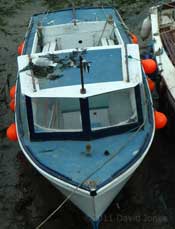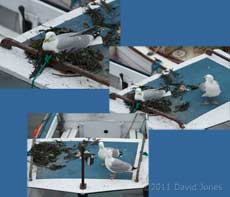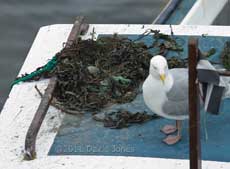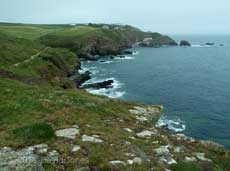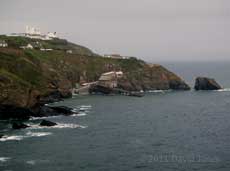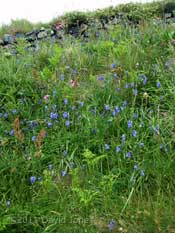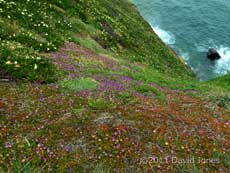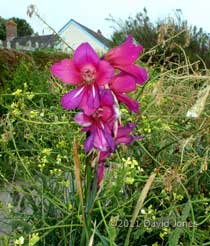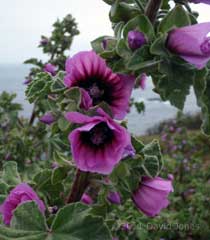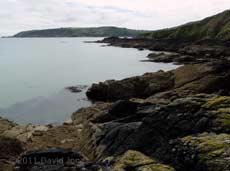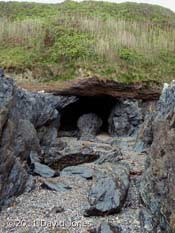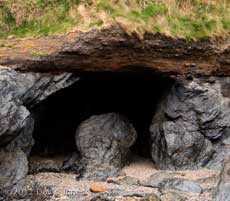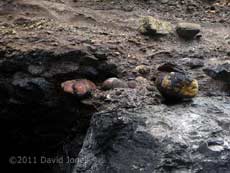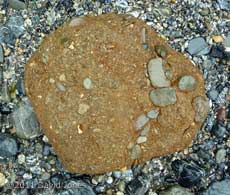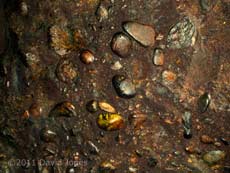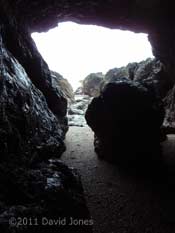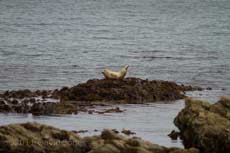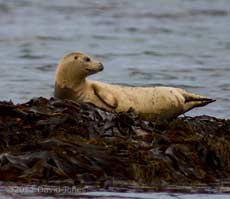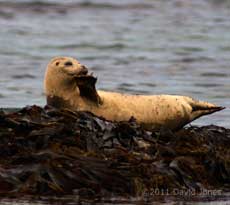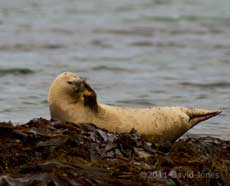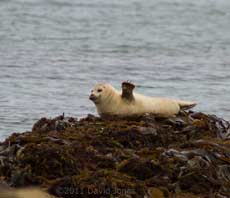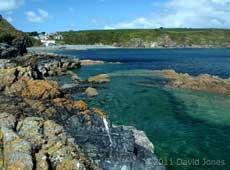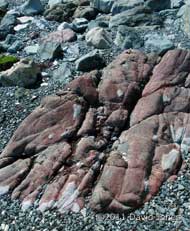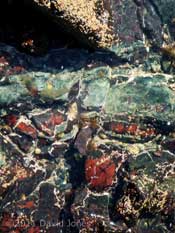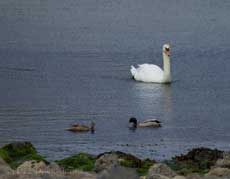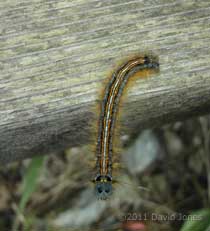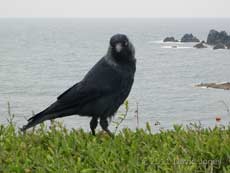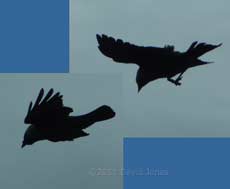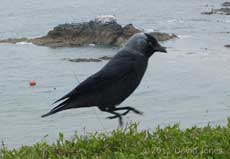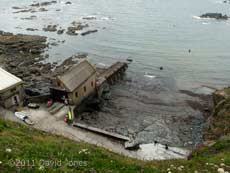Go to the last entry on this page .....Go to previous entry15 May - A sunny morning and less windy.
Excellent - the sea at Porthallow was almost flat calm and I was able to paddle to the Coast Watch station with no problem today. This view of it is a bit deceptive in that between the rocks you see on the foreshore there is sand, which probably the nearest to 'holiday beach sand' on this short section of coast!
and just below the station on this south-facing side there is a small sandy cove, although much of it is still covered with the seaweed washed in in recent stormy weather.
Anyway, my presence in the waters off the Point having been noted in their records, they were happy to give me the bearing and distance to the Eagle Hope from the station, and once back at the bungalow I was delighted to find that these figures provided a line that intersected with those I'd already drawn almost exactly, giving the distance between Porthallow beach and the Eagle Hope as 4.4km (2.25 nautical miles) - a puzzle solved.
The trip back towards Porthallow was a leisurely one, and as I approached Nare Head I had to take a picture that I've taken several times in the past, showing the beach in the distance, and the spire of the Church at St. Keverne on the skyline.
Having taken the breccia pictures yesterday, I called in a cove at what appears to be the end of the conglomerate layer. It is visible above the grey rocks to the left of the cove, but seems to be absent on the other side.
The layer has a lower band of mainly small, rounded pebbles and an upper layer of much larger, rounded stones in a hard, gritty substrate with rusty patches, the whole deposit hard enough to form the roofs of the caves and survive the action of rough seas when the wind blows from the south-east.
The book contains a picture of the cave with a large boulder in its entrance that I have photographed on previous holidays, and Barton identifies the band as a consolidated beach, with the land above being of glacial origin. He describes how it is bound together with a black ferrous or calcareous cement and is tough enough not just to resist marine erosion but also to have been used as a building stone. It was deposited immediately before the last glacial period.
16 May - A restful day with an afternoon visit to Lizard Point in the afternoon.
17 May - The weather is not so friendly now. After just a bit of sunshine during the morning it clouded over completely and tonight it is wet outside, with a touch of Cornish mist for the first time this holiday. After a slow start we headed to Porthleven around noon. Porthleven is situated right where the west coast of the Lizard peninsular meets the rest of Cornwall. Its position means that its harbour has to be able to cope with very rough seas from time to time.
If a major storm threatens this can be closed by lowering a series of large wooden beams across it, using a crane that positions them to fit metal 'slots' fitted to both sides.
The clock tower in the background is often featured in pictures that show the effect of waves during storms.
In the inner harbour most boats are neatly organised in rows, left high and dry during Spring Tides.
Boats left at moorings inevitably attract the attention of gulls which can leave quite a mess, but in one corner of the harbour the owner of one boat has a slightly different problem -
a pair of gulls is nesting on the cabin roof!
While I watched, its partner returned, standing next to the nest to preen. After a couple of minutes the sitting bird left the nest to preen briefly before sitting again.
That short time away from the nest left a single egg revealed.
Mid-afternoon we headed back to Lizard Point for a meal, and this time it was eaten indoors for the first time this holiday.
Afterwards I went for a walk westwards along the coast path as far as the Old Lizard Point. There is a good view from there back to Lizard Point,
but today there was a touch of dampness in the air and it was dim enough for the light from the lighthouse to show up in pictures.
On a day like this there seem to be precious few insects about to enjoy the flowers that decorate the hedgerows and the coastal path, and which have become more evident during our holiday.
In addition to the Thrifts that have already featured in several pictures, there are still patches of Bluebells, although these have clearly passed their prime now.
In contrast to these native flowers, the most noticeable colours other than green on the cliffs around Lizard Point are now yellow and purple, provided by those unwelcome South African invaders the Hottentot Fig and the Purple Dew plant.
At the side of the path there is a single example of another native of South Africa, a Whistling Jack - a garden escape that has been spreading slowly along roadside verges, especially on the west side of the Lizard. Unlike the other two plants this species doesn't appear to be a threat to the native vegetation of the Lizard coastline.
And finally a very impressive native plant, the Tree Mallow, with its purple flowers on stems that can be more than six foot tall.
18 May - After last night's mist this morning started wet, and for the first time this holiday we had to use the car's windscreen wipers as we drove to St. Keverne to pick up supplies before heading down to Porthallow. It was still drizzling when we drove onto the beach, but calm seas and optimism had me preparing the kayak once again.
I set myself a limit of Nare Head, and by the time I got there the drizzle had been replaced by sunny spells. This was the view back towards Porthallow form the shore just before the headland. You can just make out the beach over the low headland near the top-centre of the picture. The most distant headland is Porthkerris.
During the outward portion of my journey there were a few bird sightings to record. First I had just reached the rocks that mark the northern limit of the cove when a gull took off from just a couple of yards from me with a large starfish in its beak - it would have made a good picture. Just a short time afterwards I spotted a single Oystercatcher - the first one here this year, although yesterday I saw a trio of them fly past Lizard Point. However, the highlight of the journey came when I rounded some rocks and saw a pair of Shelducks. This is the first time that I've ever seen this species here. Unfortunately, the tide was very low (Spring tide today) and they were hidden from me until I got too close, so I didn't get a chance to photograph them before they flew off.
Having mentioned the cave with the boulder in its entrance a couple of days ago I decided to take advantage of the very low water to visit it and take a few photographs.
Barton's book (see entry for 14 May), published in 1964, includes a black and white photograph of the cave, taken at low tide, and I was interested to see how much the cave entrance may have changed in subsequent years. I'm not able to show a copy of that picture, but it is almost identical in proportion to this one taken today. More interestingly the cave entrance appears almost unchanged after 47 years.
At the top-right corner of the opening are several rocks that protrude a long way out of the matrix. It looks as though these were in a similar state when the original photograph was taken.
Some erosion of the raised beach deposit must have taken place over this time, but the only evidence I could see of relatively recent loss was this well rounded boulder, about 2ft across on the pebble beach in front of the cave.
Walk inside the cave and look up and you will see pebbles embedded in the cave roof which have been polished by wave action, just like the killa rock that forms its walls.
Look out past the boulder and you can see the long split (known as a zawn in Cornwall) in the rocks that must have been eroded away by sea action - to what extent did that happen before (or after) the laying down of the beach deposits?
Tonight the skies are clearing and temperatures could drop to around 5C. However, it looks as though tomorrow could be sunny.
19 May - A sunny start gave way to a rather grey morning before sunshine was switched on again to give us a very pleasant, and warm afternoon before the skies turned hazy. The morning was spent down in Porthallow once again with me heading out on the kayak. One reason for today being warmer was a change in the wind direction to south-westerly, and that had an effect on the sea. There was a gentle swell for the first time this holiday, although the only time I had to be wary of it was when I paddled into one of the zawns. Then one had to be cautious not to be dumped on the rocks at the shore end! It was still calm enough to paddle all the way to Nare Point once again. There was no sign of the Shelducks today. During today's trip I didn't take any photographs, and it was only when I returned to Porthallow and was hauling the kayak back up the beach that I spotted a reason to use my camera - a seal hauled out on a rock off the south side of the cove.
Over the last few years we have become used to seeing a seal in the water - the usual view of a head looking around and disappearing every-so-often, but this is the first time I've seen one hauled out here - as well as the first seal I've seen this holiday.
Handling my 'proper' camera while still wearing a salty wetsuit wasn't the best thing to do so after taking just a couple of pictures from too far away (just in case it was disturbed) I changed back into my 'land clothes'. During that time the inevitable happened and someone decided to see just how close he could get, causing the seal to retreat into the water. I got on with putting the kayak and its bits and pieces away, and as I put the last bits away the seal returned to its perch.
With the tide now coming in the seal wasn't going to be there much longer so I headed down over the rocky foreshore to a solid area of rock away from the water's edge to spend an enjoyable few minutes watching and photographing it. Notice how the fur looks darker and smoother where wet. The flies all over its back didn't seem to bother it at all,
although occasionally it found it necessary to deal with a itch on its chin,
or nose.
And a couple of times it would simply stretch, giving a good view of a set of claws.
Eventually the tide covered the rock and the seal headed back into the water once more, just in time as someone else with a compact camera decided that they needed to get as close as possible to get a photograph. I wonder if it will be around tomorrow... Then it was off to Lizard Point for a meal before heading back to the bungalow for the evening.
20 May - A bright start to the day had us heading down to Porthallow once again for what will probably be the final time this holiday. However, this time the only reason for the kayak being taken off the car roof was to pack the trolley bits under it for the trip home on Sunday.
Instead of paddling I took a walk along the foreshore to the south of the cove as the tide went out to look for interesting vantage points to take some photographs back towards the cove. The ripples on the water were caused by a strong breeze that persisted all dayand blew down the valley making it feel cold whenever the sun was hidden by clouds.
The rocks on the south side of the cove contrast greatly with the mainly grey killas on the north side. There is a variety of colour, from grey to red, such as this boulder which is well rounded compared with other rocks in the same area.
And there are the near Technicolor combinations that show up well, as here in a small rock pool.
There was no sign of the seal today, not even a head above water at low tide. However, when I got back to the car I spotted a Heron down at the water's edge in front of us, so I got out my big lens and fitted it on the camera. Then, just as I walked away from the car the Heron's head went down and came up with a large fish which it promptly carried aloft, heading off across the bay and disappearing beyond the cliff.
While the strong breeze continued, the steep beach shelters the first few yards of sea at low tide, so the expression 'smooth as a mill-pond' described the spot where this pair of Mallard Ducks were feeding on the green algae that thrive where a stream flows into the sea. This spot is also the main attraction for the Swans that live here.
It was back to the Olympus for the final pictures at Porthallow, and it was Sheila who spotted this little caterpillar racing across the gravel of the beach. In contrast with the bold stripes along the length of its body its head is a plain, matt blue.
21 May - Our final day in Cornwall (for now!), and the morning was taken up packing and relaxing before we headed down to Lizard Point for a meal at the Polpeor Cafe. Apparently they had rain a bit earlier, but it was dry and bright, if mainly cloudy during our stay and we were able to sit outside.
Whenever you sit at one of the tables nearest the cliff edge it is inevitable that you'll have at least one guest during the meal as the local Jackdaws try to entice you with their piercing eyes to throw them some crumbs. They were out of luck at our table, but nevertheless there was one coming and going throughout our meal.
A westerly wind meant that there was a really strong flow of air up the cliff in front of us (although we were sheltered by the hedge). This up draught provides a stage for the Jackdaws to demonstrate their hovering skills just feet away. Unfortunately, one failing of my little Olympus camera is its shutter delay, so most attempts to get photographs of them in flight failed miserably....
When bits of bread etc are thrown onto the hedge some pieces will fall into gaps in the top of the hedge. Searching for these requires the Jackdaws to walk about on what is a very uneven surface - sometimes one has to jump across holes!
Finally, a last look down into Polpeor Cove where the sea has now reclaimed most of the seaweed that we saw washed up on our first visit. With the weed cleared it also shows that the cove has, for the time being at least, also lost some of the sand that covered the rocks seen here on its right side.
That is in contrast to changes at Porthallow. At low Spring tides a sand bar is uncovered at the base of the gravel slope of the beach, and over the last few years the bar has been growing. I must take a picture of it next time we are in Cornwall.
Click on images to see larger version
|
|
